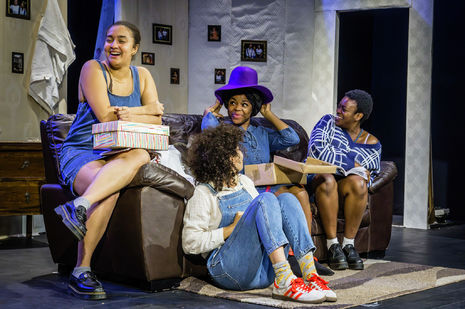A Raisin in the Sun embraces identities cast in shadow
Ziyana Kotadia reflects on this provocative glimpse into racial tensions at the domestic level

Illuminating life at the intersection of poverty and racism, Keziah Prescod’s production of A Raisin in the Sun examines the journey of a black family as they attempt to create a sense of place and belonging in deeply hostile terrain.
The audience is invited to look in on how tension, care, and longing are negotiated among the Younger family: matriarch Lena, daughter Beneatha, son Walter Lee, his wife Ruth, and their child Travis. Together, they yearn for upward mobility through a racially stratified class system in 1950s Chicago – yet each member of the family has a different concept of how to do so.
“The performance is compelling from the start”
Misplaced and unfulfilled dreams line the journeys of each character. Though the anticipation of an insurance check arriving in the mail for Lena after the death of her husband represents a potential entry point into a better life, even the promise of more money than the family has ever seen is not enough for everyone. $10,000 cannot move the family into a house in a better neighbourhood, support Walter’s liquor store venture, and fund Beneatha’s medical school tuition.
The living space designed by Anna Peterson evokes intimacy right from the play’s opening. The performance is compelling from the start as the characters move through their environment with ease and familiarity, bringing us into the world of their worn and well-lived-in home.
Over the course of the play, Lena, Beneatha, and Ruth each differently navigate a nexus of gendered familial and romantic expectations. Rachael Oloyede-Oyeyemi delivers a masterful performance as Lena, physically embodying the character’s age with skill and attention to detail. Qawiiah Bisiriyu beautifully captures the passion and anxiety of Beneatha as she moves through university life and romantic entanglements, attempting to piece together a transatlantic sense of self and find identity somewhere in the hyphen between African-American.
“There is an attempt to find identity somewhere in the hyphen between African-American”
Maya Moh’s Ruth, too, is articulated with nuance and emotional depth as she grapples with questions of bodily autonomy. Prescod makes a powerful directorial choice in relegating Ruth to the corner kitchen and busying her with domestic work throughout the play, underscoring the character’s attempts to negotiate womanhood in the face of her husband Walter’s bids to restore his sense of masculinity. Together, these three performances call attention to the unequal landscape of gender relations that intersect with economic hardship and racial prejudice to create a particularly vivid set of challenges.
The heartbeat of this play is the Younger family’s collective struggle to love one another in the face of financial insecurity and the expectation to embrace Blackness only insofar as it is palatable to white tastebuds. Though the chemistry between characters is captivating, many of the play’s moments of intimacy or pain take place too far upstage or behind furniture, leaving the audience to reach for moments that could have been crafted to be closer to them. Yet there were a few beautiful exceptions; notably Ruth and Walter dancing in the romantic afterglow of their reconciliation and Beneatha’s refusal to credit God for her family’s trajectory.
“The chemistry between the characters is captivating”
While the lighting shifts were seemingly haphazard and often diverted the audience’s attention from the central action of the scene, Melania Hamilton’s costume design was clever and comprehensive: the blue, black, and white palate nodded to the family’s working-class context and emphasized the relational network that the characters are embedded in. The production flirts with the use of a cappella, with choral song closing the show and Moh’s exceptional voice grounding the audience back in the world of the play after intermission. While worthwhile and emotionally resonant, the limited use of a cappella only in the second half of the play left me wishing this musical motif had been woven throughout the performance.

Showstopper!: Where the audience gets the pen
Indeed, the voices of the chorus rising together offstage as the family prepares to move into a new home was a powerful note to end on. As the Langston Hughes poem from which the play is named suggests, A Raisin in the Sun culminates around dreams deferred and desires unmet. We are left without certainty about the family’s future but are offered something far more compelling as the play draws to a close: hope. A thoughtful and soul-stirring performance.
 News / Caius mourns its tree-mendous loss23 December 2025
News / Caius mourns its tree-mendous loss23 December 2025 Comment / Yes, I’m brown – but I have more important things to say22 December 2025
Comment / Yes, I’m brown – but I have more important things to say22 December 2025 News / Cambridge welcomes UK rejoining the Erasmus scheme20 December 2025
News / Cambridge welcomes UK rejoining the Erasmus scheme20 December 2025 News / CUP announces funding scheme for under-represented academics19 December 2025
News / CUP announces funding scheme for under-represented academics19 December 2025 Interviews / Politics, your own way: Tilly Middlehurst on speaking out21 December 2025
Interviews / Politics, your own way: Tilly Middlehurst on speaking out21 December 2025









